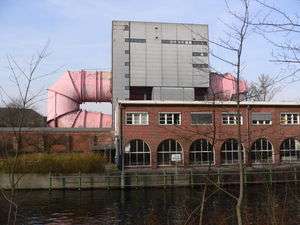Water tunnel (hydrodynamic)

A water tunnel is an experimental facility used for testing the hydrodynamic behavior of submerged bodies in flowing water. It is very similar to a recirculating wind tunnel but with water as the working fluid, and related phenomena are investigated, such as measuring the forces on scale models of submarines or lift and drag on hydrofoils. Water tunnels are sometimes used in place of wind tunnels to perform measurements because techniques like particle image velocimetry (PIV) are easier to implement in water. For many cases as long as the Reynolds number is equivalent, the results are valid, whether a submerged water vehicle model is tested in air or an aerial vehicle is tested in water. For low Reynolds number flows, tunnels can be made to run oil instead of water. The advantage is that the increased kinematic viscosity will allow the flow to be a faster speed (and thus easier to maintain stably) for a lower Reynolds number.
Whereas in wind tunnels the driving force is usually sophisticated multiblade propellers with adjustable blade pitch, in water and oil tunnels the fluid is circulated with pumps, effectively using a net pressure head difference to move the fluid rather than imparting momentum on it directly. Thus the return section of water and oil tunnels does not need any flow management; typically it is just a pipe sized for the pump and desired flow speeds. The upstream section of a water tunnels generally consists of a pipe (outlet from the pump) with several holes along its side and with the end open followed by a series of coarse and fine screens to even the flow before the contraction into the test section. Wind tunnels may also have screens before the contraction, but in water tunnels they may be as fine as the screen used in window openings and screen doors.
Additionally, many water tunnels are sealed and can reduce or increase the internal static pressure, to perform cavitation studies. These are referred to as cavitation tunnels.

Methods
Because it is a high-speed phenomenon, a special procedure is needed to visualize cavitation. The propeller, attached to a dynamometer, is placed in the inflow, and its thrust and torque is measured at different ratios of propeller speed (number of revolutions) to inflow velocity. A stroboscope synchronized with the propeller speed "freezes" the cavitation bubble. By this, one can observe if the propeller would be damaged by cavitation. To ensure similarity to the full-scale propeller, the pressure is lowered, and the gas content of the water is controlled.
Often, a tunnel will be co-located with other experimental facilities at a Ship model basin.
List of cavitation tunnels (water tunnels)
Australia
Brazil
- Laboratory of Naval and Oceanic Engineering (LENO), Institute for Technological Research (IPT) of São Paulo.
Canada
- National Research Council—Institute for Ocean Technology Cavitation Tunnel,[2] St. Johns, Newfoundland.
France
- "Tunnel de Cavitation" Ecole Navale,[3] Lanveoc
- "Grand Tunnel Hydrodynamique" Bassin d'Essais des Carènes,[4] Val de Reuil
Germany
- Multiple cavitation tunnels at the Versuchsanstalt für Wasserbau und Schiffbau,[5] Berlin
- Large Cavitation tunnel at Hamburg Ship Model Basin,[6] Hamburg
- Multiple cavitation tunnels at the Oskar von Miller Institut,[7] Technical University of Munich
India
- Fluid Control Research Institute, Palakkad, Kerala.
- Cavitation Tunnel of the Naval Science and Technology Labs at Visakhapatnam.
- Indian Institute of Technology Madras.
Iran
- Applied Hydrodynamics Laboratory, Iran University of Science and Technology,[8] Narmak, Tehran.
- Marine Engineering Laboratory, Sharif University of Technology,[9][10] Azadi Av., Tehran.
Italy
- Department of Naval Architecture, University of Genoa.
- INSEAN Cavitation facility, INSEAN (National Institute of Studies and Experiments in Naval Architecture), Rome.
The Netherlands
- Large Cavitation Tunnel and High Speed Cavitation Tunnel at Maritime Research Institute Netherlands in Wageningen
Norway
Spain
Serbia
- The Large Cavitation Tunnel at Military Technical Institute Belgrade, Serbia
Switzerland
- High Speed Cavitation Tunnel at LMH: Lab. of Hydraulic Machines, EPFL: Ecole Polytechnique Federale de Lausanne, Switzerland
Taiwan
- The Large Cavitation Tunnel at National Taiwan Ocean University, Keelung, Taiwan
United Kingdom

United States
- The Garfield Thomas Water Tunnel The Pennsylvania State University,[12] State College, PA
- The William B. Morgan Large Cavitation Channel,[13] Memphis, TN
- David Taylor Model Basin, Carderock Division of the Naval Surface Warfare Center
- Water Tunnel, The University of North Carolina at Charlotte,[14] Charlotte, NC
See also
References
- ↑ Discover your future at AMC | AMC
- ↑ Cavitation Tunnel - NRC-IOT
- ↑ Ecole Navale
- ↑ cadre
- ↑ http://www.tu-berlin.de/vws/w3vwsde/w3facide/w3faciuk.htm|
- ↑ HSVA - Hamburgische Schiffbau-Versuchsanstalt
- ↑ http://www.wb.bv.tum.de/index.php?option=com_content&view=article&id=110&Itemid=92
- ↑ Archived April 9, 2010 at the Wayback Machine
- ↑ Archived November 13, 2007 at the Wayback Machine
- ↑ Archived August 23, 2007 at the Wayback Machine
- ↑ http://www.ncl.ac.uk/marine/about/facilities/emerson.htm
- ↑ GTWT
- ↑ Large Cavitation Channel (LCC)
- ↑
External links
- "Under Water Speed Way..." Popular Mechanics, July 1949
- Description of a commercial water tunnel showing the inlet baffle, flow conditioning screens, and converging section.
- Contains a nice picture of a water tunnel with PVC pipe and turbopump.
- These show the clear difference between a recirculating wind tunnel and a water tunnel.
- A miniature water tunnel whose return section is simply a reservoir tub with a sump pump. Flow rate is controlled by constricting the flow on the outlet of the pump with a valve.